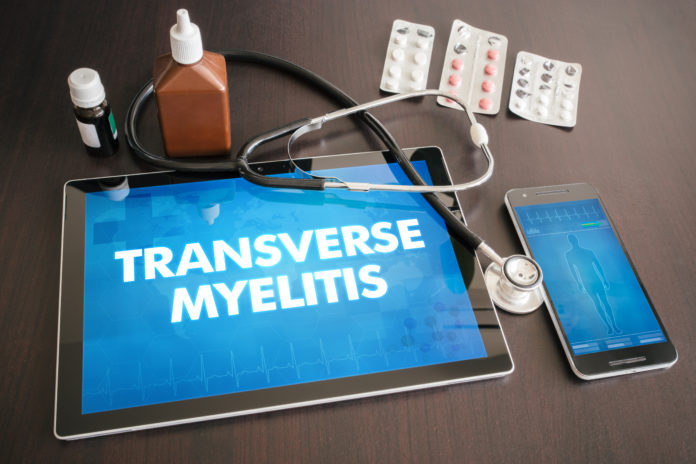Transverse myelitis (TM), a rare neurological syndrome, is an inflammatory disorder of the spinal cord. The exact cause of transverse myelitis is not known. TM is considered an autoimmune disorder, which means the immune system attacks one’s own tissues.
What is Transverse myelitis?
Transverse myelitis (TM) interrupts messages that are sent by the spinal cord nerves throughout the body. This can result in sensory problems, paralysis, pain, muscle weakness, or bladder and bowel dysfunction. There are numerous different causes of TM, such as infections and immune system disorders which attacks the tissues of the body. Transverse myelitis can also be caused by other myelin disorders like multiple sclerosis
What causes Transverse Myelitis?
While the exact reason for transverse myelitis is not known, at tiimes there are some known cause. In most of the cases, this inflammatory disorder appears after recovery from fungal, bacterial or viral infections.
Viruses linked to transverse myelitis include:
- Mumps, measles and rubella
- Herpes viruses, including those that causes shingles & chickenpox (zoster)
- HIV
- Epstein-Barr
- Enteroviruses such as poliovirus and coxsackievirus
- Cytomegalovirus
- Zika Virus
- Influenza
- Hepatitis B
Bacterial infections linked to transverse myelitis are:
- Tuberculosis
- Syphilis
- Lyme disease
- Tetanus
- Actinomyces
- Diphtheria
- Pertussis
- Gastroenteritis, bacterial skin infections, and a few types of bacterial pneumonia may also cause transverse myelitis.
Other conditions that can trigger Transverse myelitis are:
- Neuromyelitis Optica (Devic’s disease)
- Multiple sclerosis: A disorder in which the immune system destroys myelin surrounding nerves in your spinal cord and brain.
- Autoimmune disorders: Such as lupus that can affect multiple body systems and Sjogren’s syndrome
- Vaccinations: Vaccines given for infectious diseases though rarely, have been linked as a possible trigger. However, this does not indicate that a person must avoid vaccines as it is only a rare possibility.
- Sarcoidosis: A condition which leads to inflammation in many areas of your body
What are the Symptoms of Transverse Myelitis?
Transverse Myelitis takes only a few days and hours to develop in your body, then the symptoms and signs manifest in a few weeks. This disease affects both the sides of your body below the affected area of the spinal cord, but several times it occurs only on one side of the body.
Here are a few signs and symptoms of Transverse Myelitis:
- Pain: Sharp pain that shoot down your arms or legs, or around the chest or abdomen.
- Weakness in the arms or legs: While few people with transverse myelitis may notice heaviness in their legs, or they may experience stumbling or that they are dragging one foot, other people may develop severe weakness, or total paralysis as well.
- Abnormal sensations: Few individuals report tingling sensation, including sensation of coldness, numbness or burning sensation. Few others with transverse myelitis are especially sensitive to the light touch of clothing or to extreme cold or heat.
- Bladder and bowel problems: This problem may include the need to urinate more frequently, difficulty urinating, urinary incontinence and constipation.
When should I see a doctor?
Since Transverse Myelitis takes only a few hours or weeks to develop in your body, one should visit the doctor at the earliest. Several neurological disorders can cause sensory issues, like bladder and bowel dysfunction, which also need to be ruled out.
Call 1860-500-1066 to book an appointment
How do I prevent Transverse Myelitis?
Since Transverse Myelitis is an autoimmune disorder, its causes and methods of prevention are still unknown.
What is the treatment of Transverse Myelitis?
Many people get at least a partial recovery. The entire treatment process may take approximately a year or more. However, studies have proven that the improvement may occur within the first three months after the disease gets diagnosed. The success of the treatment may also depend on the cause of Transverse Myelitis.
Many therapies target acute signs and symptoms of transverse myelitis, including:
- Antiviral medication
- Plasma exchange therapy
- Intravenous steroids
- Pain medication
Nerve pain can be treated with antidepressant drugs, and anticonvulsant drugs
Your doctor may recommend other medicines as required to treat problems like urinary or bowel dysfunction, depression, muscle spasticity, or other complications linked to transverse myelitis.
Other therapies
Other therapies that focus on long-term recovery, as well as care include:
- Occupational therapy
- Physical therapy
- Psychotherapy
Conclusion
Since Transverse Myelitis is a rare disease and the response to its treatment takes time, it is important to seek medical care at the earliest.
Frequently Asked Questions (FAQs)
Is Transverse Myelitis Hereditary?
No, Transverse Myelitis is not hereditary or contagious. It is impossible to pass the risk of being affected by this disease to your family.
During which age Transverse Myelitis is prone to occur?
Transverse Myelitis can affect people of almost every age, be it a 5-month-old infant or 80-year-old adult. But the peak age for this disease to occur are from 10 to 19 and 30 to 40 years of age. It can happen to males and females as well.
What is the most common symptom of Transverse Myelitis?
This disease causes variable symptoms. Weakness in the legs, arms, and bowel and bladder dysfunction are the most common symptoms include.
Is Transverse Myelitis considered to be a disability?
About one-third of individuals suffering from transverse myelitis fall into one of following three categories after an attack:
- No or slight disability: Such people have only minimal lingering symptoms.
- Moderate disability: These individuals are mobile, but may experience numbness or tingling, difficulty in walking, and bladder and bowel problems.
- Severe disability: A few may need a wheelchair permanently and may require ongoing assistance with daily care and activities.


















